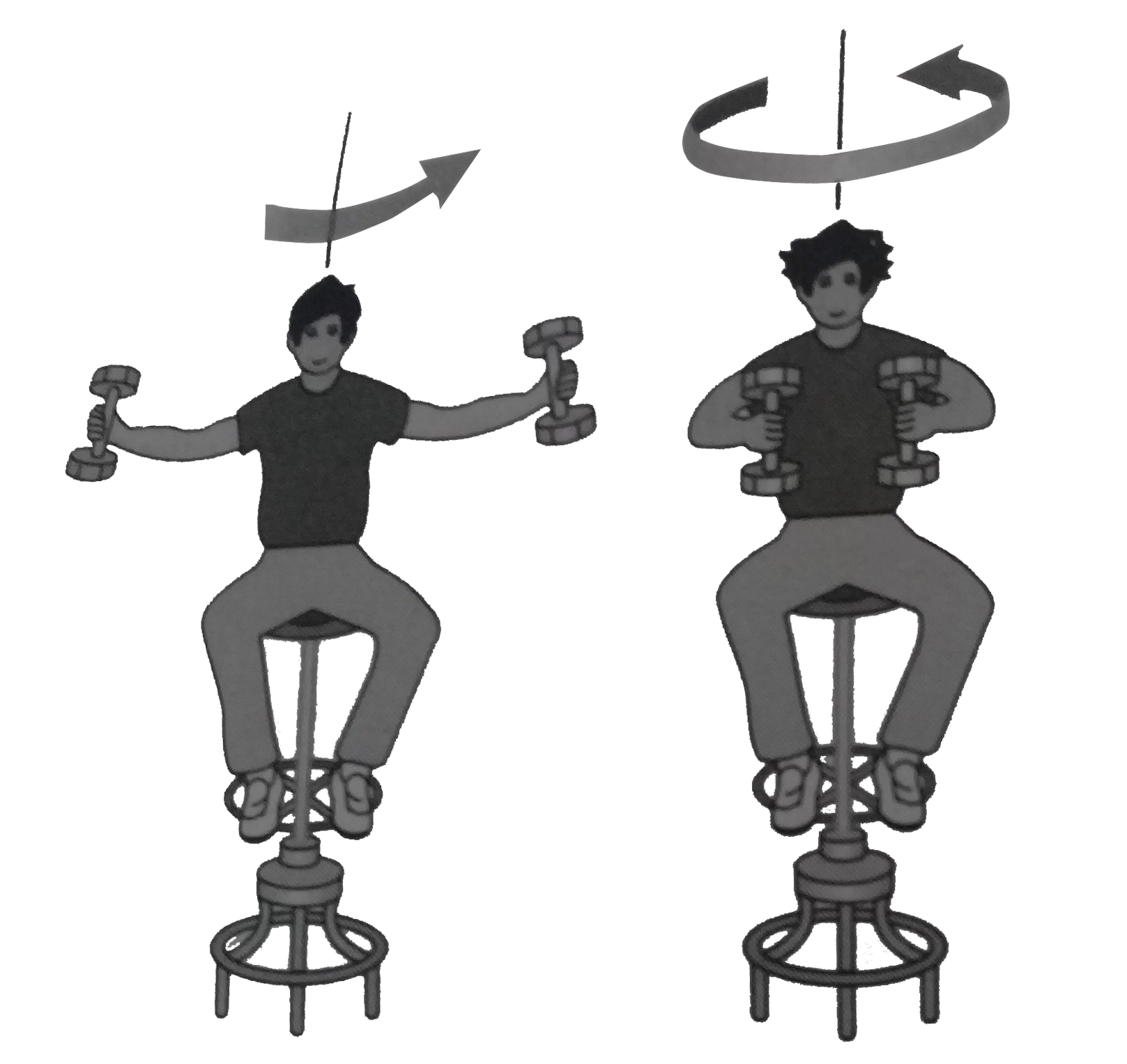A student sits on a freely rotating stool holding dumbbells, each of mass 5.0kg (Fig). When his arms are extended horizontally (Fig a), the dumbbells are 1.0m from the axis of rotation and the student rotate with an angular speed of 1.0rad/s. The moment of inertia of the student plus stool is 5.0kg.m2 and is assumed to be constant. The student pulls the dumbbells inward horizontally to a position 0.50m from the rotationa are (Fig.) The new angular speed of the student is.
 .
.
1.5rad/s
2.5rad/s
2.0rad/s
1.25rad/s
The correct Answer is:C
( c) The total angular momentum of the system of the student, the stool, and the weight about the axis of rotation is given by
I→tal=Iweights+Istudent=2(mr2)+5.0kg.m2
Before : r=1.0m
Thus, Ii=2(5.0kg)(1.0m)2+5.0kg.m2=15kg.m2
After : r=0.50m
Thus, Ii=2(5.0kg)(0.50m)2+5.0kg.m2=7.50kg.m2
We now use conservation of angular momentum
Ifωf=Iiωi
or ωf=(IiIf)ωi=(15.07.5)(1.0rad/s)=2rad/s.
Topper's Solved these Questions
- ROTATIONAL DYNAMICSBOOK - A2ZCHAPTER - ROTATIONAL DYNAMICSEXERCISE - Work And Energy In Case Of Rotation
22 Videos
- ROTATIONAL DYNAMICSBOOK - A2ZCHAPTER - ROTATIONAL DYNAMICSEXERCISE - Rotation And Translation Combined And Rolling Motion
18 Videos
- ROTATIONAL DYNAMICSBOOK - A2ZCHAPTER - ROTATIONAL DYNAMICSEXERCISE - Torque , Torque Equation And Equilibrium Of A Rigid Body
29 Videos
- PROPERTIES OF MATTERBOOK - A2ZCHAPTER - PROPERTIES OF MATTEREXERCISE - Chapter Test
29 Videos
- THERMAL PROPERTIES OF MATTERBOOK - A2ZCHAPTER - THERMAL PROPERTIES OF MATTEREXERCISE - Chapter Test
30 Videos
Similar Questions
A man stands at the centre of a circular platform holding his arms extended horizontally with 4 kg block in each hand. He is set rotating about a vertical axis at 0.5rev/s. The moment of inertia of the man plus platform is 1.6kg−m2, assumed constant, the block are 90 cm from the axis of rotation. He now pulls the blocks in towards his body until they are 15 cm from the axis of rotation. Find (a) his new angular velocity and (b) the initial and final kinetic energy of the man and platform (c) how much work most the man do to pull int he blocks?
View SolutionA sphere of mass 10 kg and radius 0.5 m rotates about a tangent. The moment of inertia of the solid sphere about tangent is
View Solution
Knowledge Check
a body of mass 10 kg and radius of gyration 0.1 m is rotating about an axis. If angular speed is 10 rad/s, then angular momentum will be:
A1kgm2/sB0.1kgm2/sC100kgm2/sD10kgm2/sA sphere of mass 10 kg and radius 0.5 m rotates about a tangent. The moment of inertia of the sphere is
A5kgm2B2.7kgm2C3.5kgm2D4.5kgm2A sphere of mass 10 kg and radius 0.5 m rotates about a tangent. The moment of inertia of the sphere is
A5 kg m2B2.7 kg m2C3.5 kg m2D4.5 kg m2
A body of moment of inertia of 3kgm2 rotating with an angular velocity or 2rad//s has the same kinetic energy as a mass of 12kg moving with a velocity of
View SolutionA ring of radius 0.5 m and mass 10 kg is rotating about its diameter with angular velocity of 20 rad/s. Its KE is :-
View SolutionA body of mass 2 kg and radius of gyration 0.5 m is rotating about an axis. If its angular speed is 2 rad/s, then the angular momentum of the body will be
View SolutionA body having M.I of 5kg−m2 about its axis of rotation is rotating with angular velocity of 6 rad/s. The kinetic energy of the rotating body is the same as that of a body of mass 5 kg moving with a speed of
View SolutionA ring of radius 0.5 m and mass 10 kg is rotating about its diameter with angular velocity of 20 rad/s. Its KE is :-
View Solution
